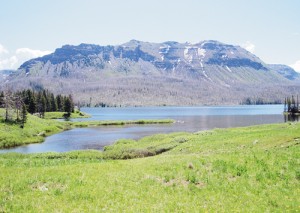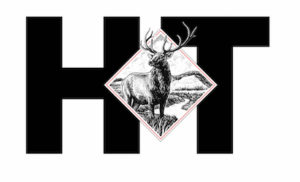
Trappers Lake in 2012 — A key player in the Wilderness Act of 1964.
Fifty years ago, the Wilderness Act of 1964 defined areas like Trappers Lake as places “where the earth and its community of life are untrammeled by man, where man himself is a visitor who does not remain.”
In commemoration of these words, Blanco Ranger District and the White River National Forest have given me the opportunity to write three articles that will place Trappers Lake within the broader history of the wilderness movement. Despite the standard definition provided by the Wilderness Act, our understanding of wilderness has changed over time. The wilderness concept has its own history, and Trappers Lake played an important role in its evolution.
Some readers might be familiar with the story of Arthur H. Carhart, who, in 1919, visited the area and recommended that the United States Forest Service preserve it from future development. Yet, as this first article will show, Carhart’s recommendation must be understood within the context of American culture and politics during the early 20th century.
Carhart certainly believed that Trappers Lake was worthy of wilderness preservation because of its natural beauty. More important than the scenery, however, were Carhart’s own assumptions about the role that places like Trappers Lake should play in a modern age.
Typically, wilderness has been portrayed as the antithesis of civilization. The majority of European settlers in North America perceived wilderness as places where individuals could be killed or revert to the ways of witchcraft and the devil.
During the height of the Industrial Revolution in the 19th century, people such as Henry David Thoreau or John Muir believed that experiencing wild nature could bring a person closer to God. Their time at Walden Pond or in the Sierra Nevadas was not solely for pleasure. Rather, they were pilgrimages.
This is what Thoreau meant when he wrote his famous phrase, “In wildness is the preservation of the world.” By going “into the wild,” so to speak, these individuals hoped to have God’s work unveiled to them so they could receive a truer understanding of the world.
By the early 20th century, however, areas like Trappers Lake became places where individuals and families could seek pleasure or rest from their everyday responsibilities.
Three trends in particular made this possible, all of which contributed to the wilderness concept that many of us know today.
The first was increased use of the automobile. For example, there were more than 10 million registered automobiles in the United States by 1922, compared to just 1 million a decade earlier. Expanded car ownership gave more Americans the opportunity to access the outdoors. To do so, they traveled on an ever-expanding road network within the U.S.
These roads constituted the second important element behind the evolution of the modern wilderness idea. Starting in the 1910s, federal, state and local governments contributed to the growing popularity of the outdoors by building roads, designating parks and forests, and developing campgrounds under the idea that such initiatives promoted the public good.
The final component that stimulated the wilderness preservation movement was the emergence of a consumer economy in the United States. By the 1920s, an excursion “into the wild” had become a commercial activity for most Americans, in which they spent money on gas or the latest camping equipment and relied heavily upon lodging accommodations, restaurants and other service industries during their travels.
In turn, these industries expanded significantly to meet the demands of motorists.
It was within this context that Arthur Carhart arrived at Trappers Lake (by car, no less) during the summer of 1919 at the behest of the U.S. Forest Service (USFS). The trends mentioned above placed greater pressure on the agency to accommodate those who wanted to utilize the national forests for recreational purposes.
In regard to Trappers Lake, a privately owned resort had operated in the area since 1892 and several cabins dotted its shoreline. To facilitate even greater access to Trappers Lake and other areas of the national forests, the USFS granted permits for the construction of summer homes and started to expand its roads, campgrounds and trails network.
Thus, Arthur Carhart started his survey for the potential construction of cabins and roads around Trappers Lake. However, as he later commented in his book, “Timber in Your Life,” Carhart grew increasingly troubled as he went about his work.
“The place was getting a strange hold on me,” he wrote, a feeling that he feared would be gone forever if summer homes and automobiles shattered the lake’s tranquility. Therefore, he returned to his supervisors in Denver with two suggestions that went on to become important pillars of the modern wilderness movement.
First, he proposed that the area immediately surrounding Trappers Lake should remain roadless and free from further development. This reasoning supports the conclusion made by environmental historians that the modern wilderness movement emerged largely in reaction against roads and motorized vehicles.
Second, Carhart argued that access to Trappers Lake should remain public. He feared that cars and homes would hinder the enjoyment of the area. Therefore, in addition to recommending against development in the immediate vicinity of Trappers Lake, he proposed certain improvements elsewhere that would facilitate public access to the entire area, including better sanitation, campgrounds, roads and hiking trails.
When examined in this way, the designation of Trappers Lake as the “cradle of the wilderness” can be misleading. Carhart did not want to separate the lake from the modern world by preventing the wholesale construction of roads or other developments. Rather, by determining exactly where such improvements could be established, Carhart tried to integrate Trappers Lake with modernity.
By understanding the relationship between Arthur Carhart and Trappers Lake within this context, we can begin to comprehend where the lake fits within the evolution of the modern wilderness movement.
For instance, it is significant that Carhart did not use the word “wilderness” following his visit to Trappers Lake. Rather, he argued that the USFS should strive to accommodate national forest visitors, the overwhelming majority of whom traveled by car.
“The Forest Service … is obligated to make the greatest return from the total forests to the people of the nation that is possible,” he wrote in a 1919 memorandum to Aldo Leopold (another progenitor of the modern wilderness idea). Scenery and outdoor recreation were among those forest resources. Saving certain areas such as Trappers Lake from development was only part of a comprehensive land-use planning strategy that Carhart believed the USFS should adopt; one that balanced American desires for “undeveloped country,” as he wrote, with demands for “telephone and telegraph lines, modern plumbing and other conveniences.”
Fire, rock, ice and water may have created Trappers Lake and the stunning backdrop that many visitors appreciate today. However, its emergence as a desirable wilderness area — one that all people could enjoy — was purely the result of human initiative. Nor was such a designation inevitable after Carhart’s visit.
By Dr. Matt Pierce
Special to the Herald Times





















